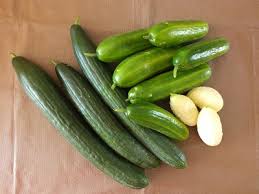Cucumbers (and bananas) have seeds that lie freely in the flesh, and are therefore "berries" botanically seen as tomatoes and melons. Cucumbers and gherkins (Cucumis sativus) are botanical seen completely identical. They differ in appearance and are used differently, because we as consumers wish so. And then they are grown and selected to this use for over 3,000 years.
 The result is that cucumbers are smooth, straight and dark green, 35 to 39 cm long, 5 cm diameter and 350 to 400 grams. We cut them into slices preferably for salad or garnish. (There are also smaller 'snack and mini cucumbers’.)
The result is that cucumbers are smooth, straight and dark green, 35 to 39 cm long, 5 cm diameter and 350 to 400 grams. We cut them into slices preferably for salad or garnish. (There are also smaller 'snack and mini cucumbers’.)
Gherkins because they are young plucked are much smaller, to about 12 cm long and knobbly. We put them in vinegar, little ones in their entirety and sometimes larger in pieces. Then they are pickles.
(I bake them both, like zucchini.)
The predecessors of the present species were more bitter, and had spines. Both properties are largely culled by selection. With aging, the fruits are also bitter. (As some people.)
They are also selected to grow no (or very little), seeds and even be formed without fertilization. The only female flowers constitute fruit without pollination. This is called parthenocarpy. If they are pollinated they get less tasty fruits, also with seeds.
They are heat-loving plants that perform best thrive here under glass.
The plants with tendrils attach themselves onto supports. They can be either grown up on the ground or on ropes. The advantage of hanging plants is that they take up less space and are not dirty. Dozens of cucumbers grow on one stem.
The plants are usually topped at 2 meters, shoots are pruned after the appearance of the fruit.
They grow quickly, so you need to pick at regular basis (at least every 2 days).
If you let the fruits become greater, the growth of new fruit stops.
They are never stored in the refrigerator (4°C). At low temperatures, they will spoil. Keep them (briefly) in a dark, cool place (13°C).
The fruits for +94% consist of water. The calorie content is low (10 kcal per 100 g pulp). Beloved feed for diet followers.
Gherkins pickling
Wash the jars and screw lids and rinse well / put them in hot water. Apply vinegar with equal water and some sugar to taste, salt and spices (dill, bay leaf, peppercorns and mustard seed) to boil. Put the washed fruits in the (hot) jars. Fill them with acid to the edge and close them with the screw cap.
(Smooth) luffa (Luffa aegyptiaca) or sponge gourd is one year old, thorny climber with cylindrical, 10-40 cm long and 8 cm wide fruit. Inside is a reticulated tangle of vascular bundles, which when ripe and dry is solid. The ripe fruits are peeled and soaked in water for several days in order to remove the pulp and the seeds. Mesh fabric is used as bath sponges ("loofah"), for filters and insoles.
Young, soft fruits are like pickles eaten as a vegetable. (Older well as laxatives and emetics.) The tropical plant needs three months warm weather to produce edible unripe fruits and 4 months for the ripe fruit that can be used as sponge.
